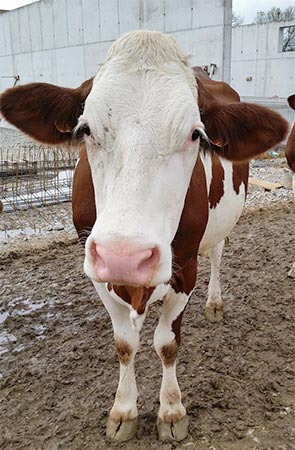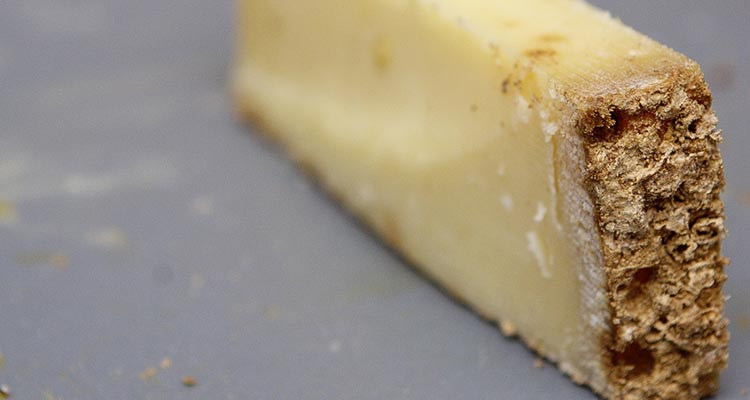If it’s possible to fall in love with cows without actually being a cow, I think this happens to me in one particular cheese-making region of France. Standing by a meadow, watching the soft, square faces of the brown-and-white Montbéliarde bovines, with their compact, casual Alpine demeanor as they stroll by, curiously approaching my camera lens, it’s all over for me.
Why am I in the Jura mountains falling in love with cows?
It starts at the annual Commanderie dinner in Bordeaux – as one often does in April, after a day of tasting the top local wines en primeur. I’m practically licking my plate at the end of the delectable meal, while at the front of the room, extremely stylish château owners make speeches to each other in French.
And then comes the cheese course. As I’ve been taught, I select only two samples from the perfectly-ripened platter. One of my choices is… something lovely, no doubt. But the other is the most velvety, creamy, hearty rectangle of pale gold I could ever imagine, shot through with an irresistible tang of umami. Where has this cheese been all my life, I wonder. And what the heck is it?
It’s called Comté.
Though it looks like what we in the US call Swiss cheese, and comes from the French Jura mountains, on the border of Switzerland, its flavor — earthy and pungent and nutty and smooth – is nothing like the plasticized slices found in stateside supermarkets. Immediately I determine I must have more of this cheese. And I must learn more about this cheese.
And I must eat more of this cheese. (Did I already say that?)
As I wax lyrical, the others at my table are probably looking at me strangely, because they all know Comté is one of the most traditional and popular cheeses in France. It has been appellation-protected (AOC) since 1958, yet they are too polite to say anything.
Upon returning to the US, I receive an email from an old friend from Champagne, asking if I’d like to visit the Comté region of France. I immediately reply “Yes!” (Why does this happen? How do I go from discovering an ethereally earthy new cheese to being invited to the region? Who knows? I’m not about to question it.)
The month of June that same year finds me landing at the Geneva airport and driving over the top of the Jura Mountains, through tiny villages with narrow, flower-bedecked streets lined with neat stone houses and shops. Surrounding the towns, there are lush pastures for the cows that contribute their prized milk to Comté. At my first meal, I find myself lingering over a scrumptious Comté fondue in a little tavern next to my hotel, which whets my appetite (even more than it already was) to learn all about this new obsession.

Comté is a raw milk, pressed cheese. The milk is transported from 2,600 small dairy farms to 150 small cheese-making facilities, called fruitières. There’s terroir in cheese, and all the milk that goes to a fruitière must come from no further than 16 miles away. Inhabitants of the region all have their favorite fruitières.
It takes the milk of 20 cows to make one wheel of Comté, each of which weighs about 80 pounds. I find it ironic that this raw milk cheese is from the birthplace of Louis Pasteur, who has a statue in one of the town centers. But in Pasteur’s day the milk wasn’t tested twice a daily like it is now: all milk is now traceable back to every farm and herd.
We go to a farm and walk out to the edge of the fragrant fields dotted with wild flowers to watch the brown and white cows wander in for their evening milking. In this region there are approximately 130,000 cows that produce the milk for Comté. They are 95% Montbéliarde breed and 5% French Simmental.
The farms are small, with cows numbering only in the dozens. Every one has a name; those born in the same year begin with the same letter. Certain herd leaders (and other favorites) are adorned with embroidered neckbands holding huge, clanking cowbells, and they’re all trained to come back from the pastures for milking twice a day – though a farmer with a herding dog does accompany them.
These may be the most well cared-for cows in France. Each must have 2-1/2 acres of pastureland to graze in, and a further 2-1/2 acres-worth of hay to cut for winter feeding, all of which add minerals and color to the protein in the milk. They wait patiently, adorably in line for cleaning and milking — and afterwards, at one of the farms I visit, even have the option of standing under a massaging back brush!
Earlier this year, when I found I could arrange a few days in Geneva, I began plotting a return to the Comté region. One farmer, Marie-Ange Roy, agreed to see me on the weekend. Unfortunately, this turned out to be far from the easy drive I remembered: I spent hours twisting and turning along lanes and byways to get to her farm in Vevy, passing through dozens more villages than I had originally visited. Later I found out that the whole region is 890 square miles!
It was early May and Marie-Ange had cows of all ages, and they were starting to go out to pasture daily, after wintering in the barn. I was introduced to two Simmental baby calves who had just arrived that day, to add diversity to the Montbéliarde herd. The rainy afternoon found them napping together on a cushiony bed of sweet straw in a very large pen. True to their curious nature, they got up and came over to inspect me – and get a closeup taken.

When the rain stopped, I went out to meet Marie-Ange’s cows who were strolling in for their evening milking, deep clanging cowbells announcing their arrival. Friendly, whiskered brown and white faces turned toward me as the parade passed by us, with several of the ladies breaking ranks to review us more closely. Is it their expressions, their solid stature or what? I don’t know, yet there I was, falling for more sweet-faced Alpine cows again.
After meeting the animals and watching the milking that day, I went to Marie-Ange’s local fruitière to buy vacuum-sealed Comté to take home. The cheese was as dreamy as the cows: complex, softly nutty, and nourishing. (I’m eking out the last morsels as I write this.) In the US – and other countries – Comté can be found at most cheese shops, and even my local Costco carries it.
Though there’s a minimum requirement of four months, most people prefer Comté aged in the neighborhood of six. As it gets older, this cheese intensifies in flavor, becoming less buttery and more toasty. It is generally, however, ready to eat upon purchase, and does not require any further aging. Unlike other cheeses, longer ageing isn’t generally preferable with Comté – but this is a matter of personal taste. (To determine one’s own style preference, consider what was happening four to six months before it was purchased. Was this from winter milk or summer milk?)
Comté goes beautifully into fondue and other melty dishes; or simply cut into thick matchsticks and served with plain crackers or crusty bread.
Finally, what wine to drink with Comté cheese? Wines of the Jura, of course, such as Vin Jaune, the lightly oxidized white. Continuing in that vein, one might try sipping an Oloroso sherry, too. Or one of the other local white or light red wines produced in the Jura. Perhaps even a young, bright pinot noir from nearby Burgundy.

Featured image by traaf

